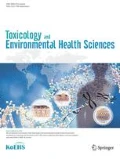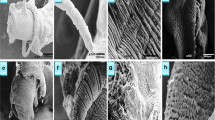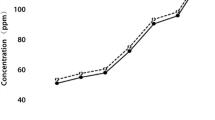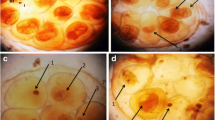Abstract
Biomphalaria alexandrina snails play a central role in transmission of schistosomiasis. The present study evaluates the molluscicidal effect of two plants as aqueous suspensions, Cestrum diurnum and Casimiroa edulis. LC50 values were 66 and 195 ppm, respectively after 24 hours. Exposure of snails to sub-lethal concentrations of C. diurnum and C. edulis resulted in significant alterations in the activities of some haemolymph enzymes (alanine aminotransferase, aspartate aminotransferase and alkaline phosphatase). The digestive gland cells were highly vacuolated in all tested concentrations. The secretory cells were atrophied and degenerated at LC25 of C. diurnum, while in snails treated with LC0 of C. edulis; they were densely colored without differentiation between nucleus and nucleolus.
Similar content being viewed by others
References
Borch, M. et al. Schistosomiasis: A case study. Urol. Nurs. 29, 26–29 (2009).
Lotfy, W. M., Dejong, R. J., Abdel-Kader, A. & Loker, E. S. A molecular survey of Biomphalaria in Egypt: Is B. glabrata present? Am. J. Trop. Med. Hyg. 73, 131–139 (2005).
Oliveria-Filho, E. C. & Paumgartten, F. J. Toxicity of Euphorbia milii latex and Niclosamide to snails and non-target aquatic species. Ecotoxicol. Environ. Saf. 46, 342–350 (2000).
Tripathi, S. M. & Singh, D. K. Molluscicidal activity of Punica granatum bark and Canna indica root. Braz. J. Med. Biol. Res. 33, 1351–1355 (2000).
Mantawy, M. M. & Mahmoud, A. H. Effect of Allium cepa and Allium sativum feeding on glucose, glycogen, protein bands profile and phenol oxidase activity in Biomphalaria alexandrina. J. Egypt. Soc. Parasitol. 32, 271–283 (2002).
Singh, A. & Singh, D. K. Effect of herbal molluscicides and their combinations on the reproduction of the snail Lymnaea Acuminata. Arch. Environ. Contam. Toxicol. 46, 470–477 (2004).
Luna, J. S. et al. Acetogenesis in Annona muricata (Annonaceae) leaves are potent molluscicides. Nat. Prod. Res. 20, 253–257 (2006).
Jaiswal, P. & Singh, D. K. Molluscicidal activity of Carica papaya and Areca catechu against the fresh water snail Lymnaea acuminata. Vet. Parasitol. 152, 264–270 (2008).
Mostafa, B. B., El-Deeb, F. A., Ismail, N. M. & El-Said, K. M. Impact of certain plants and synthetic molluscicides on some fresh water snails and fish. J. Egypt. Soc. Parasitol. 35, 989–1007 (2005).
Fang, W. W. et al. Molluscicidal effect of Phytolacca americana linn leaf against Oncomelania hupensis and its acute toxicity. Zhongguo Xue Xi Chong Bing Fang Zhi Za Zhi 23, 449–452 (2011).
Tripathi, S. M., Singh, V. K., Singh, S. & Singh, D. K. Enzyme inhibition by the molluscicidal agent Punica granatum Linn. bark and Canna indica Linn. root. Phytother. Res. 18, 501–506 (2004).
Mello-Silva, C. C., Vasconcellos, M. C., Pinheiro, J. & Rodrigues, M. L. A. Physiological changes in Biomphalaria glabrata say, 1818 (Pulmonata: Planorbidae) caused by sub-lethal concentrations of the latex of Euphorbia splendens var. hislopii. N. E.B. (Euphorbiaceae). Mem. Inst. Oswaldo Cruz. 101, 1–6 (2006).
El-Ansary, A., El-Bardicy, S., Soliman, M. S. & Zayed, N. Sub-lethal concentration of Ambrosia maritima (Damsissa) affecting compatibility of Biomphalaria alexandrina snails to infection with Schistosoma mansoni through disturbing the glycolytic pathway. J. Egypt. Soc. Parasitol. 30, 809–819 (2000).
Mumoli, N., Cei, M. & Cosimi, A. Drug-related hepatotoxicity. N. Engl. J. Med. 354, 2191–2193 (2006).
Bénichou, C. Criteria of drug-induced liver disorders: Report of an international consensus meeting. J. Hepatol. 11, 272–276 (1990).
Wilbrink, M., Treskes, M., DeVlieger, T. A. & Vermeulen, N. P. Comparative toxicokinetics of 2, 2′- and 4, 4′-dichlorobiphenyls in the pond snail Lymnaea stagnalis (L.). Arch. Environ. Contam. Toxicol. 19, 565–571 (1990).
Downs, C. A., Dillon, R. T., Fauth, J. E. & Woodly, C. M. A molecular biomarker system for assessing the health of gastropods (Llyanassa obsolete) exposed to natural and anthropogenic stressors. J. Exp. Mar. Biol. Ecol. 259, 189–214 (2001).
Rizvi, S. H., Kapil, R. S. & Shoeb A. Alkaloids and Coumarins of Casimiroa edulis. J. Nat. Prod. 48, 146 (1985).
Ito, K. et al. Antimutagenic constituents of Casimiroa edulis with potential cancer chemopreventive activity J. Agric. Food Chem. 46, 3509–3516 (1998).
Andréjak, M. et al. French pharmacovigilance survey evaluating the hepatic toxicity of coumarin. Pharmacoepidemiol. Drug Saf. 7, 45–50 (1998).
Perrett, S. & Whitefield, P. J. Aqueous degradation of isoflavonoids in an extract of Millettia thonningii (Leguminosae) which is larvicidal towards schistosomes. Phytother. Res. 9, 401–404 (1995).
Singab, A. B., Ahmed, A. H., Sinkkonen, J., Ovcharenko, V. & Pihlaja, K. Molluscicidal activity and new flavonoids from Egyptian Iris germanica L. (var. alba). Z. Naturforsch C. 61, 57–63 (2006).
Ahmed, V. U., Barqai, F. T. & Ahmed, R. A. Tigogenin pentasaccharide from Cestrum diurnum. Phytochem. 34, 511–515 (1993).
Gee, J. M. et al. Effect of saponins and glycoalkaloids on the permeability and viability of mammalian intestinal cells and on the integrity of tissue preparations in vitro. Toxicol. In Vitro 10, 117–128 (1996).
Francis, G., Kerem, Z., Makkar, H. P. & Becker, K. The biological action of saponins in animal systems: A review. Brit. J. Nutr. 88, 587–605 (2002).
Mantawy, M. M., Hamed, M. A., Sammour, E. M. & Sanad, M. Influence of Capparis spinosa and Acacia arabica on certain biochemical haemolymph parameters of Biomphalaria alexandrina. J. Egypt. Soc. Parasitol. 34, 659–677 (2004).
El-Gindy, H. I., Rawi, S. M., Abdel-Kader, A. & Ebeid, F. A. Comparative effect of different pesticides on the transaminases activities in haemolymph of Biomphalaria alexandrina snails. J. Egypt. Ger. Soc. Zool. 6, 131–138 (1991).
Truchliński, J. & Grela, E. Alanine and aspartate transaminase and acid and alkaline phosphatase activities in the blood serum in relation to the protein and energy levels in the pigs’ feeds. Pol. Arch. Weter. 27, 129–136 (1987).
Krample, V. Relation between serum enzymes and histological changes in liver after administration of hepatachlor in the rat. Bull. Environ. Contam. Toxicol. 5, 529–536 (1971).
Mantawy, M. I. Potential effect of Allium cepa and Allium sativum on haemolymph of Biomphalaria alexandrina, the intermediate host of Schistosoma mansoni. J. Egypt. Soc. Parasitol. 31, 711–723 (2001).
Kela, S. L. & Bowen, I. D. The histopathological effect of Detarium Microcarpum extract, a naturally occurring plant molluscicide on the mid-gut and digestive gland of Lymnaea stagnalis. Cell. Biol. Inter. 19, 175–181 (1995).
Song, G., Wang, G., Ma, J. & Yang, J. Effect of seed of Camellia sinensis on the hepatopancreas and genital system of Oncomelania hupensis. Internat. J. of Automat. & comput. 15, 170–173 (1997).
Brackenbury, T. D. The molluscicidal properties of Apodytes dimidiata (Icacinac) geographical variation in molluscicidal potency. Ann. Trop. Med. Parasitol. 93, 511–518 (1999).
Chernin, E. & Schork, A. R. Growth in axenic culture of the snail Australorbis glabratus. Am. J. Hyg. 69, 146–160 (1959).
Mecham, J. A. & Holliman, R. B. An improved feeding procedure for Biomphalaria glabrata. J. Parasitol. 58, 835 (1972).
Mahran, G. H., Saleh, M., El-Hossary, G. H., Motawe, H. M. & Mohamed, A. M. A contribution to the molluscicidal activity of Canna indica L. family Cannaceae as a method for control of Schistosoma. Egypt. J. Bilharz. 1, 279–286 (1974).
World Health Organization Molluscicide screening and evaluation. Bull. World Health Organ. 33, 567–581 (1965).
Oteifa, B. A., Mousa, A. H., Abou-El-Hassan, A. A., Mohamed, A. M. & El-Emam, M. A. Effect of certain insecticides on the control of the fresh water snails Biomphalaria alexandrina and Bulinus truncatus. Egypt. J. Bilharz. 2, 221–243 (1975).
Litchfield, J. T. & Wilcoxon, F. A simplified method of evaluating dose-effect experiments. J. Pharmacol. Exp. Ther. 96, 99–113 (1949).
Figueiredo, E. A., Gomez, M. V., Heneine, I. F., Santos, I. O. & Hargreaves, F. B. Isolation and physiochemical properties of the haemoglobin of Biomphalaria glabrata, Mollusca, Planorbidae. Comp. Biochem. Physiol. 44, 481–491 (1973).
Reitman, S. & Frankel, S. A colourimetric method for the determination of serum glutamic oxaloacetic acid glutamic pyruvic transaminases. Amer. J. Clin. Pathol. 28, 56–63 (1957).
Kind, P. R. & King, E. J. Estimation of plasma phosphatase by determination of hydrolysed phenol with amino-antipyrin. J. Clin. Pathol. 7, 322–326 (1954).
Author information
Authors and Affiliations
Corresponding author
Rights and permissions
About this article
Cite this article
Saad, AH.A., Aly, R.H., Ragab, F.M.A. et al. Effect of Cestrum diurnum and Casimiroa edulis plants on the digestive gland and its related enzymes in the freshwater snail Biomphalaria alexandrina . Toxicol. Environ. Health Sci. 4, 109–114 (2012). https://doi.org/10.1007/s13530-012-0124-7
Received:
Revised:
Accepted:
Published:
Issue Date:
DOI: https://doi.org/10.1007/s13530-012-0124-7




